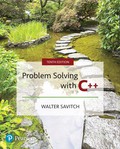
Concept explainers
My mother always took a little red counter to the grocery store. The counter was used to keep a tally of the amount of money she would have spent so far on that visit to the store, if she bought all the items in her basket. There was a four-digit display, increment buttons for each digit, and a reset button. There was an overflow indicator that came up red if more money was entered than the $99.99 it would register. (This was a long time ago.) Write and implement the member functions of a class Counter that simulates and slightly generalizes the behavior of this grocery store counter. The constructor should create a Counter object that can count up to the constructor’s argument. That is, Counter(9999) should provide a counter that can count up to 9999. A newly constructed counter displays a reading of 0. The member function void reset(); sets the counter’s number to 0. The member functions void incr1(); increments the units digit by 1, void incr10(); increments the tens digit by 1, and void incr100(); and void incr1000(); increment the next two digits, respectively. Accounting for any carry when you increment should require no further action than adding an appropriate number to the private data member. A member function bool overflow(); detects overflow. (Overflow is the result of incrementing the counter’s private data member beyond the maximum entered at counter construction.)
Use this class to provide a simulation of my mother’s little red clicker. Even though the display is an integer, in the simulation, the rightmost (lowerorder) two digits are always thought of as cents and tens of cents, the next digit is dollars, and the fourth digit is tens of dollars.
Provide keys for cents, dimes, dollars, and tens of dollars. Unfortunately, no choice of keys seems particularly mnemonic. One choice is to use the keys asdfo: a for cents, followed by a digit 1 to 9; s for dimes, followed by digits 1 to 9; d for dollars, followed by a digit 1 to 9; and f for tens of dollars, again followed by a digit 1 to 9. Each entry (one of asdf followed by 1 to 9) is followed by pressing the Return key. Any overflow is reported after each operation. Overflow can be requested by pressing the o key.
Want to see the full answer?
Check out a sample textbook solution
Chapter 10 Solutions
Problem Solving with C++ (10th Edition)
Additional Engineering Textbook Solutions
Starting Out with Java: From Control Structures through Data Structures (4th Edition) (What's New in Computer Science)
Starting Out with C++ from Control Structures to Objects (9th Edition)
INTERNATIONAL EDITION---Engineering Mechanics: Statics, 14th edition (SI unit)
Starting Out with Python (4th Edition)
Concepts Of Programming Languages
Java How to Program, Early Objects (11th Edition) (Deitel: How to Program)
- 4. def modify_data(x, my_list): X = X + 1 my_list.append(x) print(f"Inside the function: x = {x}, my_list = {my_list}") num = 5 numbers = [1, 2, 3] modify_data(num, numbers) print(f"Outside the function: num = {num}, my_list = {numbers}") Classe Classe that lin Thus, A pro is ref inter Ever dict The The output: Inside the function:? Outside the function:?arrow_forwardpython Tasks 5 • Task 1: Building a Library Management system. Write a Book class and a function to filter books by publication year. • Task 2: Create a Person class with name and age attributes, and calculate the average age of a list of people Task 3: Building a Movie Collection system. Each movie has a title, a genre, and a rating. Write a function to filter movies based on a minimum rating. ⚫ Task 4: Find Young Animals. Create an Animal class with name, species, and age attributes, and track the animals' ages to know which ones are still young. • Task 5(homework): In a store's inventory system, you want to apply discounts to products and filter those with prices above a specified amount. 27/04/1446arrow_forwardOf the five primary components of an information system (hardware, software, data, people, process), which do you think is the most important to the success of a business organization? Part A - Define each primary component of the information system. Part B - Include your perspective on why your selection is most important. Part C - Provide an example from your personal experience to support your answer.arrow_forward
- Management Information Systemsarrow_forwardQ2/find the transfer function C/R for the system shown in the figure Re དarrow_forwardPlease original work select a topic related to architectures or infrastructures (Data Lakehouse Architecture). Discussing how you would implement your chosen topic in a data warehouse project Please cite in text references and add weblinksarrow_forward
- Please original work What topic would be related to architectures or infrastructures. How you would implement your chosen topic in a data warehouse project. Please cite in text references and add weblinksarrow_forwardWhat is cloud computing and why do we use it? Give one of your friends with your answer.arrow_forwardWhat are triggers and how do you invoke them on demand? Give one reference with your answer.arrow_forward
- Programming Logic & Design ComprehensiveComputer ScienceISBN:9781337669405Author:FARRELLPublisher:Cengage
 New Perspectives on HTML5, CSS3, and JavaScriptComputer ScienceISBN:9781305503922Author:Patrick M. CareyPublisher:Cengage Learning
New Perspectives on HTML5, CSS3, and JavaScriptComputer ScienceISBN:9781305503922Author:Patrick M. CareyPublisher:Cengage Learning Microsoft Visual C#Computer ScienceISBN:9781337102100Author:Joyce, Farrell.Publisher:Cengage Learning,
Microsoft Visual C#Computer ScienceISBN:9781337102100Author:Joyce, Farrell.Publisher:Cengage Learning,


